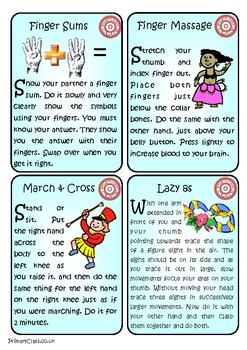
Performing Double Doodleĭouble Doodle involves coloring or “doodling” with a piece of chalk or marker in each hand at the same time. The chalk offers more resistance requiring the child to use the small hand muscles in preparation for forming letters and numbers. Some children may find using a marker that glides on a white board easier at first and then after practice begin using chalk on a blackboard. However, tracing the large eight shape involves the whole body including the shoulder muscles-making it a multi-sensory experience.
#BRAIN GYM ACTIVITY CARDS FREE HOW TO#
The up and down, left and right curvy movements teach children how to make the same movements needed to form letters. Students should perform the tracing activity three to five times with each hand and then several more times using both hands together on the marker. Lazy Eights develop visual tracking skills as the child watches his own hand movements. The large, exaggerated movements create rhythm and flow that promotes eye-hand coordination. The child traces repeatedly along the curves by either using a finger or drawing with a marker or chalk. Performing Lazy EightsĪ very large horizontal eight or infinity sign is drawn.

These activities are beneficial to all students, even those with no disability. As these movements develop coordination between the right and left hemispheres-children develop bilateral integration.
#BRAIN GYM ACTIVITY CARDS FREE FREE#
Brain gym free exercises such as Lazy Eights and Double Doodle force children to use both hands together and cross midline as they make large movements at a blackboard.

Children who have deficits in “bilateral integration” appear to be clumsy and struggle with fine-motor skills such as hand writing. Midline is an imaginary line that runs down the center of the body, dividing it into right and left sides.

Symptoms include difficulties using both hands together to perform bilateral activities, lack of hand dominance in older children and avoidance of crossing the midline of the body. Their brains have difficulties processing what they see in order to read and write. Many children with learning disabilities have a neurological impairment called “ Dysfunction in Sensory Integration (DSI), also known as “Sensory Processing Disorder (SPD).


 0 kommentar(er)
0 kommentar(er)
